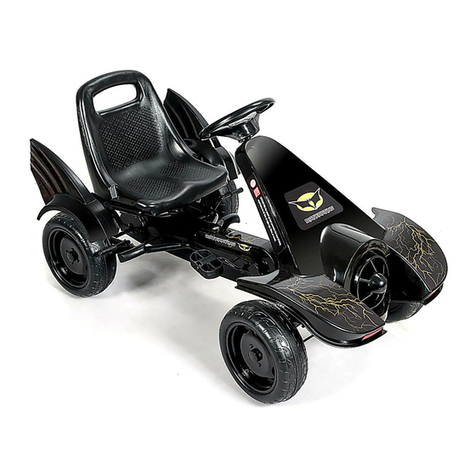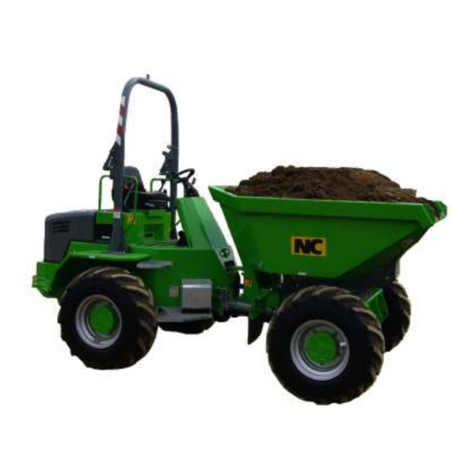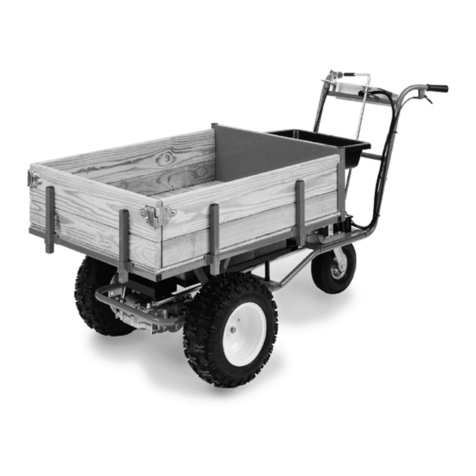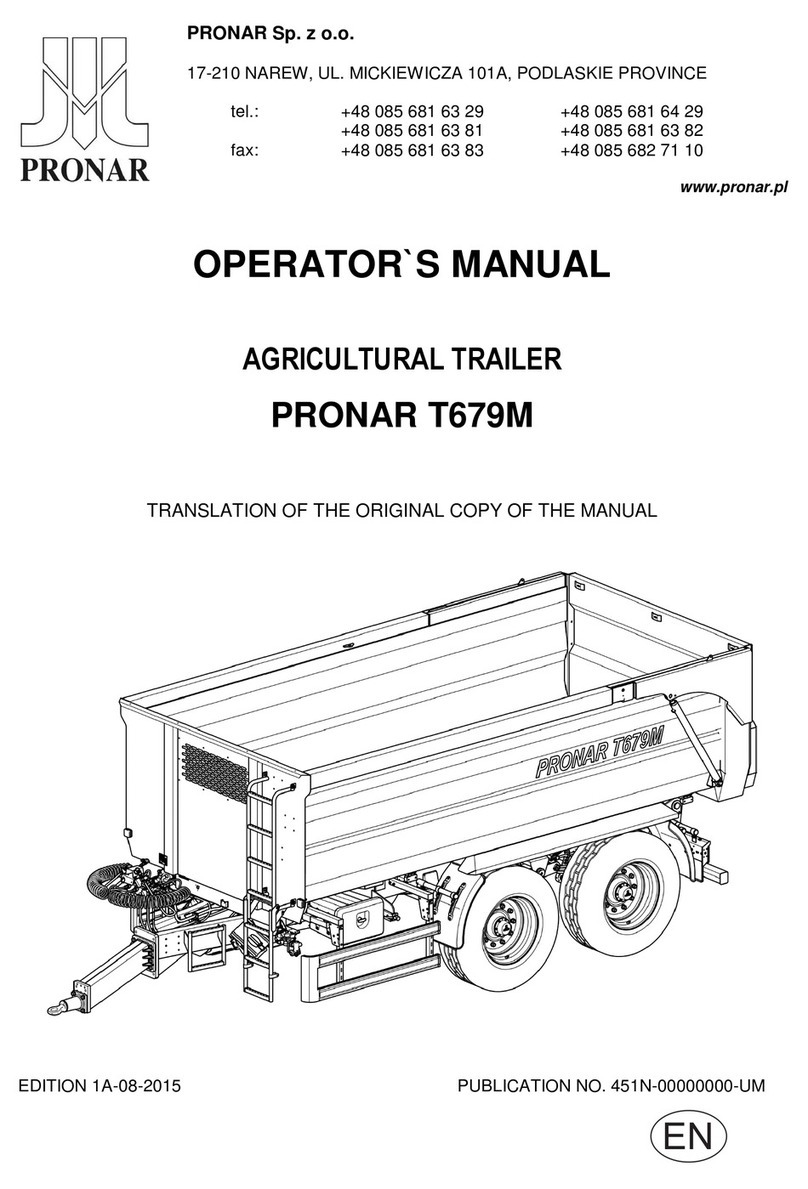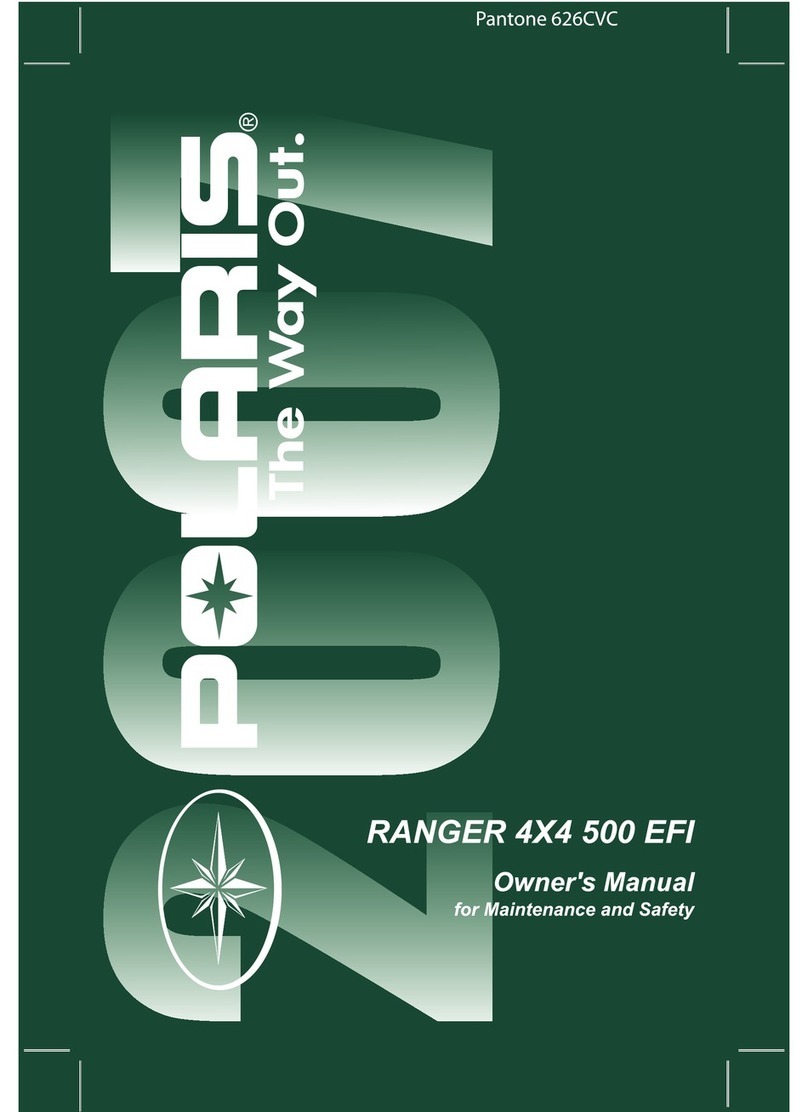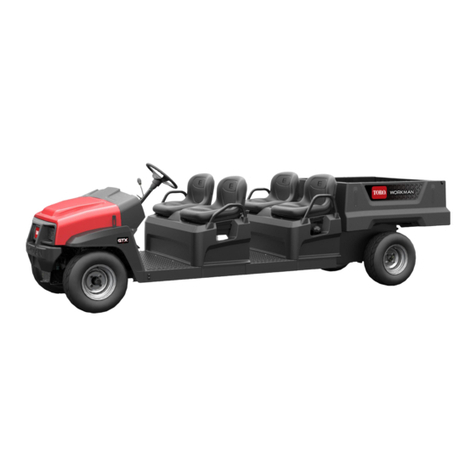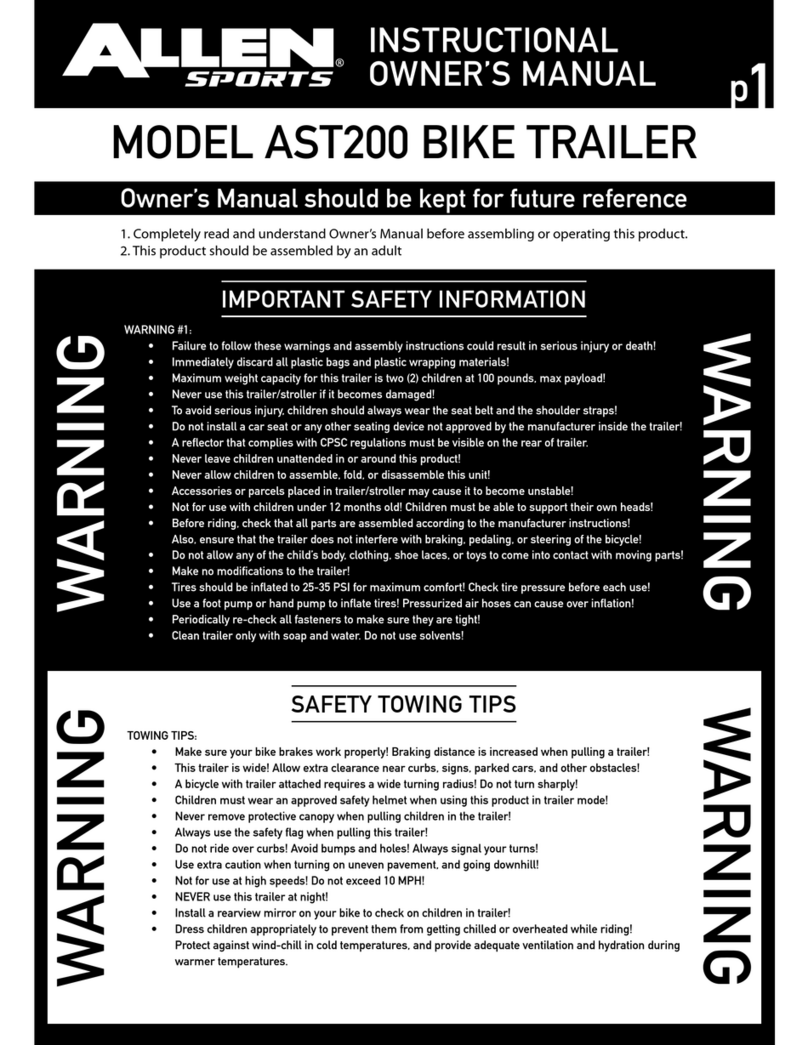SkyLine TRAVEL TRAILER FIFTH WHEEL User manual

1
TRAVEL TRAILER
FIFTH WHEEL
OWNERS MANUAL
This Quality Recreational Vehicle Built By:

2
SKYLINE CUSTOMER SATISFACTION
Skyline Customer Satisfaction is more than just a promise — We
believe you deserve quality in every aspect of ownership. To ensure
your continued satisfaction we’re dedicated to providing you with
a quality product along with the very best service available in our
industry. Skyline’s “Commitment of Excellence” will be a source of
pride and satisfaction for you.
Commitment of Excellence
OWNER
SATISFIED CUSTOMER
ORIGINAL DEL. DATE DEALER NO.
11-15-93 045454
VEHICLE ID NO. MODEL NO.
7653-0398J 2955
SAMPLE WARRANTY CARD

3
TABLE OF CONTENTS
Introduction.........................................................................................................................A
Warranty..............................................................................................................................B
Skyline Cares About You ....................................................................................................C
Your Travel Trailer — A True Recreational Vehicle............................................................1
Do’s and Don’ts for Equipment Selection and
Preparation for Towing.....................................................................................................1
Trailer Loading ....................................................................................................................2
Hitching Up..........................................................................................................................7
Hitching Procedures for Conventional Trailers ...................................................................7
Hitching Procedures for Fifth Wheel Trailers......................................................................9
Tires .....................................................................................................................................9
Changing Tires ...................................................................................................................11
The Braking System...........................................................................................................12
Trailer Driving Techniques ................................................................................................15
Stabilization .......................................................................................................................17
Utility Systems...................................................................................................................19
Utility Diagrams.................................................................................................................25
Ventilation and Condensation ............................................................................................31
The Exterior of Your Travel Trailer ...................................................................................35
The Interior of Your Travel Trailer ....................................................................................39
Fire and Emergency Procedures ........................................................................................53
Emergency Exits.............................................................................................................53
Reporting Safety Defects ...................................................................................................55
Travel Trailer and Fifth Wheel Slide-Out Room
Adjustment and Operation .............................................................................................57
Slide-Out Rooms — Hydraulic..........................................................................................60
Winterize Checklist for Travel Trailer ...............................................................................61
Travel Checklist .................................................................................................................66
Camping Checklist.............................................................................................................67
Recommended Maintenance Schedule ..............................................................................68
Warranty Information.........................................................................................................69
Skyline Recreational Vehicle Division Directory ..............................................................70
Index ..................................................................................................................................71

4

5
INTRODUCTION
We’re delighted that you chose to invest in a Skyline-built trailer. Your
new travel trailer is designed and constructed to make each trip as safe
and carefree as possible, and we won’t be satisfied until you’re completely
happy with it.
Before your first trip, please take the time to read this manual and the ap-
pliance and other manuals that come with it. They will help you to get the
most enjoyment out of your purchase.
All manuals should be kept available for easy reference.
NOTE: Some equipment and features described or shown in this manual
may be optional on some Skyline models. The term “travel trailer” as used
in this manual includes fifth wheel travel trailers unless otherwise indi-
cated.

6
HOW TO OBTAIN SERVICE
Your continued satisfaction with your travel trailer is of utmost importance to Skyline. Please fol-
low these steps for fast, efficient warranty service.
1. Inspect your travel trailer thoroughly to determine exactly what service is required.
2. Make a list of the required service. Be sure to sign it.
3. Call, write or visit your dealer.
If your request is not resolved to your satisfaction, make sure it is brought to the attention of
the owner or general manager of the dealership. They will obtain factory assistance, if needed.
NOTE: Your appliances are warranted both by the appliance manufacturer and by Skyline.
All appliances furnished with your travel trailer are “name-brands”, and the manufacturer
may have a service facility near you. If so, you may be able to obtain even faster service by
requesting service directly from the appliance manufacturer.
4. Factory: If your request has not been resolved to your satisfaction within a reasonable time,
write (include the complete serial number of your travel trailer and your telephone number
with a copy of your list of required service) and/or call the factory service representative
5. In those rare cases in which your dealer and the factory service representative have been un-
able to resolve the problem, write the Director of Consumer Relations, Skyline Corporation,
complete serial number of your travel trailer, your telephone number and a complete list of the
required manufacturer’s warranty service. Your request will receive prompt attention.
All service under your Skyline warranty will be performed without charge for either parts or
labor. Whether service is performed by the dealer, the factory or others, Skyline accepts final
responsibility for fulfillment of all its warranty obligations. Skyline will use its best efforts to
see that all manufacturer’s warranty service is completed as expeditiously as possible.
Warranty service requests must be made within the warranty period and should ordinarily go to
your dealer.
FULL ONE-YEAR WARRANTY
Manufacturing defects reported to Skyline within one year after original retail
delivery of your new Travel Trailer by an authorized dealer will be corrected
without charge and within reasonable times. Excluded are misuse (including
lack of reasonable maintenance), minor imperfections, alterations, and dealer or
owner improper transportation, installation or hookup.
This warranty gives you specific legal rights. You may have other rights which
vary from state to state.

7
SKYLINE CARES ABOUT YOU
Skyline is a leader in the recreational vehicle industry because Skyline cares about its
RV owners. Your investment in your Skyline-built travel trailer is protected by Skyline’s
extensive six-point program:
1. Product design and engineering. Skyline maintains a complete staff of professional
engineers and designers.
2. Code construction. Every travel trailer built by Skyline meets or exceeds code stan-
dards and features quality components including name brand appliances.
3. Underwriters Laboratories. The UL label on your trailer means that America’s
most respected independent testing agency has reviewed the plans and inspected the
travel trailer during production.
4. Full one-year warranty. It’s the no-nonsense guarantee printed in this manual. We
urge you to read it.
5. Full field service. Skyline and its dealers are pledged to back up the warranty with
prompt, courteous service that takes care of problems quickly and effectively.
6. Financial strength. Skyline is one of America’s soundest companies financially. You
can rely on Skyline today — and tomorrow.
To further ensure your satisfaction:
1. Your travel trailer is inspected by your dealer after it leaves the factory and before it
is delivered to you.
2. Upon taking delivery, have your dealer go over your travel trailer with you and
instruct you concerning the appliances and other working parts. Be sure to ask your
dealer to demonstrate the operation of any appliance or item of equipment which you
do not understand.
3. As with your other vehicles, your travel trailer will require regular care and main-
tenance. This manual, together with the information provided by manufacturers of
various components, provides a maintenance schedule that you can and should fol-
low to ensure safe, trouble-free service from your trailer. Studying these instructions
carefully and maintaining a good working knowledge of your trailer and how to care
for it will help you enjoy it for many miles and many years.
If you should have a problem that is not resolved to your satisfaction by your local dealer,
call or write the service manager at the factory nearest you. A list of factories can be
found in this manual.
All of us at Skyline join with your dealer in wishing you every happiness in your new
travel trailer.

8
YOUR TRAVEL TRAILER — A TRUE
RECREATIONAL VEHICLE
Your travel trailer is a vacation home on wheels. It is carefully designed for every normal
recreational use and activity including travel. It is not designed or intended to be used as
long-term or permanent, full-time housing. Long-term or full-time occupancy may lead
to premature deterioration and may, under the terms of the warranty, constitute misuse
and reduce your warranty protection.
Please refer to page 31 of this manual and review the section relating to ventilation and
condensation problems that may occur due to long-term occupancy.
WARNING: Never ride in your recreational vehicle.
Skyline strongly recommends that your recreational vehicle not be occupied while travel-
ing. It is unsafe and illegal to ride in a travel trailer in all states and it is illegal to ride in
a fifth wheel in most states. Your recreational vehicle is not equipped with seat belts or
other highway safety provisions commonly required for passenger vehicles. Also in some
emergency conditions cargo could shift suddenly resulting in injury or even death.
DO’S AND DON’TS FOR EQUIPMENT SELECTION
AND PREPARATION FOR TOWING
• Be sure the tow vehicle is large enough for your trailer or fifth wheel and has the needed
power and heavy duty running gear. It must be rated by its manufacturer to tow the gross
weight, and to carry the hitch weight of the fully loaded trailer or fifth wheel.
NOTE: Heavy duty commercial vehicles larger than one ton may be used only if an
energy absorbing hitch, such as the Air Ride Hitch™, is used to couple the recreational
vehicle to the tow vehicle. The rough ride of the larger trucks can cause structural prob-
lems to develop in recreational vehicles if an energy absorbing hitch is not utilized.
• Use a weight distributing hitch rated not less than the trailer Gross Vehicle Weight Rating
(GVWR). Follow the tow vehicle and hitch manufacturers' instructions. Install the hitch
ball as close as practical to the rear bumper to minimize rear overhang. (Does not apply
to fifth wheels.)
• Do not overtighten the weight distributing hitch spring bars. Follow the instructions of
the hitch manufacturer. When in doubt, use the less tight spring bar setting. (Does not ap-
ply to fifth wheels.)
• Use a sway control system. Install and adjust according to the instructions of the sway
control manufacturer. (Does not apply to fifth wheels.)
• Use a brake controller that automatically applies the brakes in proportion to the tow
vehicle brakes and also has a hand control for applying the trailer brakes only.
• Adjust the brake controller so that the brakes of the trailer come on as quickly as possible
without sliding the tires of the loaded trailer during strong braking.
• Inflate the rear tires of the tow vehicle to their maximum cold pressure. (See the maxi-
mum pressure rating on the rear tire sidewalls.)
• Load heavy objects and goods as close to the trailer axle(s) as possible. Do not place
heavy objects on the rear bumper or on the tongue.
Your trailer may be equipped with an optional spare tire mounted on the bumper. The bumper
is designed only to carry the spare tire, approximately 65 pounds. If the trailer is not equipped
with a spare, no load greater than 65 pounds shall be placed on the bumper.

9
The following label has been affixed to the bumper:
CAUTION: THE BUMPER IS DESIGNED TO CARRY THE SPARE TIRE ONLY.
DO NOT PLACE ADDITIONAL CARGO ON THE BUMPER.
• If possible, totally fill or empty the water tank to minimize “sloshing,” which may
affect towing stability.
• If possible, empty holding tanks to minimize “sloshing,” which may affect towing
stability.
• Be careful to load the trailer to comply with the specified maximum and minimum
tongue weight percentages. Weigh the fully loaded trailer from time to time to verify
tongue weight.
• Adjust the hitch ball height so that the fully loaded trailer is level front-to-rear when
attached to the fully loaded tow vehicle with hitch spring bars tightened. Do not
permit the front to be lower than the rear on trailers with tandem axles. (Fifth wheel
trailers are less sensitive to altitude, but should be towed near level to achieve best
stability and avoid the possibility of overloading one of the trailer axles.)
• Do not exceed the trailer Gross Axle Weight Rating(s) (GAWR), or Gross Vehicle
Weight Rating (GVWR). The fully loaded trailer should be weighed from time to
time to verify that trailer GAWR(s) and GVWR are not exceeded, and that the loads
on the right and left wheels are approximately equal. When weighing to determine
axle loading, the trailer must be fully loaded and hitched to the fully loaded tow
vehicle, with spring bars tightened. (Spring bars do not apply to fifth wheels.)
• Do not exceed the tow vehicle Gross Axle Weight Rating(s) (GAWR) or Gross
Vehicle Weight Rating (GVWR). Weigh the tow vehicle from time to time to verify
these loadings. When weighing, the tow vehicle must be fully loaded with goods,
passengers, and driver, and must be hitched to the fully loaded trailer, with spring
bars tightened. (Spring bars do not apply to fifth wheels.)
TRAILER LOADING
Proper trailer positioning and loading are important not only for ease of hauling, but for
safety. The correct loaded weight on the hitch is a minimum of eight percent of trailer
weight. Fifth wheel trailers should carry higher hitch loads (15 to 25 percent). If insuf-
ficient weight is placed on the hitch, the trailer will tend to move from side to side, or to
“fishtail”, which can be dangerous. Towed trailers are designed to have proper weight on
the hitch for balance when the trailer floor is level.
All objects should be held securely in place. Loose items can cause interior damage and
erratic trailer movements. They can even be a hazard to others if they fall out. Load shifts
can affect driving and handling enough to cause serious, unexpected danger. Inspect tie-
downs and fastenings, as well as the load at regular intervals every hour or two, depend-
ing on roads, curves, hills, and speed. The first check should be made within a half hour
after the trip is started or after the first 25 miles, since some initial settling is likely.

10
If you are going on a long trip, take a “shakedown cruise” of a few miles the weekend
before you leave. This will test your load, safety equipment, hitch, and might reveal
things you missed or forgot. By getting everything in order before you leave home, you
can prevent delays and annoyances that could take the fun out of your trip.
Many owners place luggage, camping equipment, bicycles, and other items in the travel
trailer. The weight of everything put on or in a trailer, whether temporarily or permanent-
ly built-in, must be included in figuring the total load.
CAUTION: OVERLOADING OR IMBALANCED LOADING OF YOUR TRAV-
EL TRAILER CAN AFFECT HANDLING OR CAUSE AN ACCIDENT THAT
COULD RESULT IN SERIOUS INJURY OR DEATH.
Follow procedures on the “Caution” label located on your kitchen overhead door to deter-
mine actual weight of the loaded trailer.
Proper loading of the trailer is extremely important. Weight ratings must not be exceeded
and proper weight distribution must be maintained. Please follow procedures on the
“Caution” label and reference the following trailer weight information label, which are
both located on your kitchen overhead door, to determine actual weight of the loaded
trailer.
TRAILER WEIGHT INFORMATION
VIN OR SERIAL NUMBER
GVWR (GROSS VEHICLE WEIGHT RATING) IS THE MAXIMUM PERMISSIBLE WEIGHT OF THIS TRAILER WHEN
FULLY LOADED. IT INCLUDES ALL WEIGHT AT THE TRAILER AXLE(S) AND TONGUE OR PIN.
UVW (UNLOADED VEHICLE WEIGHT) IS THE WEIGHT OF THIS TRAILER AS MANUFACTURED AT THE FACTORY.
IT INCLUDES ALL WEIGHT AT THE TRAILER AXLE(S) AND TONGUE OR PIN. IF APPLICABLE, IT ALSO INCLUDES
FULL GENERATOR FLUIDS, INCLUDING FUEL, ENGINE OIL AND COOLANTS.
CCC (CARGO CARRYING CAPACITY) IS EQUAL TO GVWR MINUS EACH OF THE FOLLOWING: UVW, FULL FRESH
(POTABLE) WATER WEIGHT (INCLUDING WATER HEATER) AND FULL PROPANE WEIGHT.
CARGO CARRYING CAPACITY (CCC) COMPUTATION
GVWR....................................................................................................
MINUS UVW .......................................................................................
MINUS FRESH WATER WEIGHT OF
GALLONS @ 8.3 LB/GAL
MINUS PROPANE WEIGHT OF
GALLONS @ 4.2 LB/GAL
=CCC FOR THIS TRAILER*...............................................................
*DEALER INSTALLED EQUIPMENT WILL REDUCE CCC
CONSULT OWNER MANUAL(S) FOR SPECIFIC WEIGHING INSTRUCTIONS AND TOWING GUIDELINES.
POUNDS KILOGRAMS

11
The following definitions have been provided for reference:
Gross Axle Weight Rating (GAWR) means the value specified by the vehicle manufactur-
er as the load-carrying capacity of a single axle system, as measured at the tire / ground
interfaces.
Gross Vehicle Weight Rating (GVWR) means the maximum permissible weight of this
trailer when fully loaded. It includes all weight at the trailer axle(s) and tongue or pin.
The GVWR is equal to or greater than the sum of the Unloaded Vehicle Weight (UVW)
plus the Cargo Carrying Capacity (CCC).
Dry or Unloaded Vehicle Weight (UVW) means the weight of this trailer as built at the
factory. It includes all weight at the trailer axle(s) and tongue or pin. If applicable, it
includes full generator fuel, engine oil, and coolants. The UVW does not include cargo,
fresh water, Propane, or dealer installed accessories.
Cargo Carrying Capacity (CCC) is equal to GVWR minus each of the following: UVW,
full fresh (potable) water weight (including water heater), full Propane weight. Cargo
Carrying Capacity (CCC) means the maximum permissible weight of personal belong-
ings, food, fresh water, Propane, tools, and dealer installed accessories. (CCC is equal or
less than GVWR minus UVW.)
The total weight, including liquids, groceries, clothing, etc. must not exceed the Gross
Vehicle Weight Rating (GVWR) stated on the label on the left front of your trailer. The
total load on the front and rear wheels must not exceed the respective Gross Axle Weight
Rating (GAWR) shown on the label.
1. The total trailer weight (dry weight of standard unit plus options added plus water
stored plus liquid wastes in holding tanks plus all cargo) must not exceed the GVWR
stated on the label of your trailer.
2. The total load of your fully loaded trailer on the tires when connected to the towing
vehicle must not exceed the combined total Gross Axle Weight Rating (GAWR). The
GAWR is also stated on the tag on the front left side of your trailer.
3. Establish the weight of your fully loaded trailer by weighing at a public scale. Con-
tact the police department for the location of the nearest one. Weigh separately:
a. The load on the front jack.
b. The total weight on the wheels and jack when disconnected from the towing
vehicle.
c. The weight on the wheels when connected to the towing vehicle.
4. Do not permit tongue weight (“3-a” above) to exceed your hitch manufacturer’s
recommendation. It should be eight to 15 percent of the total travel trailer weight.
5. Weight “3-b” must not exceed the GVWR.
6. Weight “3-c” must not exceed the combined total GAWR.
7. Equalize side to side loading. Store heavy objects on or near the floor.

12
8. Avoid towing with waste holding tank(s) full or partially full. If unavoidable, drive
slowly until one or both tanks can be dumped.
9. Keep water tank either completely full or empty when towing to avoid the shifting of
weight of a partially filled tank.
For Fifth Wheel Travel Trailers
1. Use a fifth wheel hitch for a two-inch SAEJ 700 king pin; an Atwood (or equivalent)
25,000 pound 2-5/16 inch diameter folding ball plate for units equipped with the
Atwood 25,000 pound GVW gooseneck coupler; and a truck capable of towing the
trailer GVWR.
2. The total of your fully loaded trailer on the tires when connected to the towing
vehicle must not exceed the combined total Gross Axle Weight Rating (GAWR). The
GAWR is stated on the tag on the front left side of your trailer.
3. Establish the weight of your fully loaded trailer by weighing it at a public scale.
Contact the police department for the location of the nearest one. Weigh separately:
a. The load on your truck rear wheels when connected to your trailer.
b. The total weight on the wheels and jacks when disconnected from the towing
vehicle.
c. The weight on the wheels when connected to the towing vehicle.
4. Do not permit the rear axle load (“3-a” above) to exceed your truck manufacturer’s
GAWR for the rear axle or your fifth wheel manufacturer’s recommendations.
5. Weight “3-b” must not exceed your trailer GVWR.
6. Weight “3-c” must not exceed your trailer combined total GAWR.
7. The weight on the hitch, derived from subtracting the weight on the wheels (3c)
from the total weight of the fifth wheel (3b), should be between 15 - 25% of the total
weight (3b) for good towing.
See your dealer if you have any questions on these rules and other towing tips.
These procedures should be repeated whenever there is any change in vehicles or loading
to ensure that you do not exceed the ratings.
STORAGE
The storage facilities in your trailer have been designed to remain secure while in motion.
Exterior compartments have key operated locks. Drawers rest in small notches or dents
when closed; to open lift slightly to clear the dent, then pull open. When storing articles:

13
• Always keep tools and equipment stored in areas where they will not shift while
traveling.
• Wherever possible, place heavy articles in storage compartments which are low
and near the axles for better weight distribution.
• Pack articles carefully in the storage compartments to minimize shifting. If nec-
essary, use straps to prevent movement.
• Be sure liquid containers are capped and cannot tip or spill. Secure all glass
containers and dishes before traveling.
• Secure all free standing furniture.
• Exterior storage compartments may not be watertight in all climate conditions.
Carry any articles which could be damaged by water inside the trailer.
WARNING: OUTSIDE STORAGE COMPARTMENTS ARE NOT SEALED. They
are vented enclosures, and are accessible from inside the trailer. Therefore, DO NOT
STORE FLAMMABLE, VOLATILE LIQUIDS, HAZARDOUS CHEMICALS OR
EQUIPMENT IN THESE AREAS.
SPECIAL TRANSPORTATION PROVISIONS
If your recreational vehicle has been equipped with an entrance door greater than 36
inches in width and an access ramp for that door, only then can your recreational vehicle
be used to store motorized vehicles or equipment.
WARNING: ONLY TRAILERS CONSISTING OF BOTH A DOOR (WIDTH
GREATER THAN 36 INCHES) AND AN ACCESS RAMP ARE CAPABLE OF
TRANSPORTING OR STORING MOTORIZED VEHICLES OR EQUIPMENT.
DANGER: ANY MOTORIZED VEHICLE OR ANY MOTORIZED EQUIPMENT
POWERED WITH FLAMMABLE LIQUID CAN CAUSE FIRE, EXPLOSION,
OR ASPHYXIATION IF STORED OR TRANSPORTED WITHIN THE RECRE-
ATIONAL VEHICLE.
The following steps should be taken to aid in reducing the risks associated with transport-
ing, storing, or cohabitation with motorized equipment and vehicles:
1. Do not allow passengers to ride inside the vehicle storage area while vehicles
are present.
2. Doors and windows in walls of separation are to be closed while the vehicles
are present.
3. Run fuel out of engine of stored vehicles after shutting off fuel at the tank.
4. Do not store or transport motor fuel inside this vehicle.
5. Ventilate the interior of the trailer to reduce the risk of fire, explosion, or
asphyxiation.

14
6. Do not operate gas appliances, pilot lights, or electrical equipment when
motorized vehicles or motorized equipment are inside the vehicle.
FAILURE TO COMPLY COULD RESULT IN AN INCREASED RISK OF
FIRE, EXPLOSION OR ASPHYXIATION.
WARNING: IT IS NOT SAFE COHABITING IN THE INTERNAL
COMBUSTION ENGINE VEHICLE STORAGE AREA WHILE
VEHICLES ARE PRESENT. FAILURE TO FOLLOW THESE
IMPORTANT PRECAUTIONS MAY RESULT IN SERIOUS INJURY
OR DEATH.
7. Load and store your motorized vehicles and equipment according to the
trailer loading and trailer storage sections in this manual.
WARNING: DO NOT EXCEED THE TRAILER GVWR WHEN
LOADING YOUR TRAILER.
8. During transit, secure motorized vehicles and motorized equipment so that
items do not move while in transit.
9. Remove carpet from section where fueled vehicles or motorized equipment
will be stored.
10. Disconnect 12-volt and 120-volt wiring when transporting motorized
equipment by use of the 12-volt cutoff switch and 120-volt circuit breakers.
HITCHING UP
Hitching your trailer to the tow vehicle will become routine with experience. Make it a
habit to examine all hitch components before hitching the trailer. If you have a conven-
tional ball hitch, check for cracked or bent parts, cracked welds, deformed or stripped
bolts. Inspect the spring bars and chains. Be sure the ball is tight and well lubricated.
Check the trailer tongue for cracks. Be sure the ball locking device works freely. Inspect
the safety chains. If you find a defect in any hitch component, correct it before towing the
trailer.
If you have a fifth wheel trailer, check all truck-mounted hitch components. Check for
worn, cracked, or bent parts. Be sure the locking device works properly. Inspect the pin
box assembly on the trailer. Check the king pin. If you find any defective components,
repair or replace them before towing. Be sure all moving parts of the hitch are well lubri-
cated.
HITCHING PROCEDURE FOR
CONVENTIONAL TRAILERS
Before attempting to hitch up your trailer, read the instructions provided by the manufac-
turer of the hitch. Some Skyline trailers accept a 2 inch ball, while others accept a 2-5/16
inch ball. The following instructions apply in most cases. If the instructions provided with
your hitch are different from these instructions, follow those of the hitch manufacturer:
1. Turn the tongue jack crank clockwise. This will raise the tongue and coupler. Raise
the tongue sufficiently to clear the hitch ball on the tow vehicle.
2. Back the tow vehicle until the hitch ball is under the hitch ball socket. If you are
working alone, a backing aid mirror may be helpful.

15
3. The coupler latch locking lever on the tongue should be fully open. Lower the tongue
jack until the ball is firmly seated in the socket. Close the coupler latch and secure it
with a locking pin or bolt.
4. Raise the tow vehicle and trailer with the tongue jack high enough to allow room to
install the hitch spring bars.
5. Attach the spring bars according to the hitch manufacturer’s instructions.
WARNING: FOLLOW THE INSTRUCTIONS OF THE HITCH MANUFAC-
TURER FOR ADJUSTING THE WEIGHT DISTRIBUTING HITCH. OVER-
TIGHTENING OF HITCH SPRING BARS WILL REDUCE CORNERING
AND STOPPING ABILITY AS WELL AS TOWING STABILITY.
6. After adjusting the spring bars, raise the jack to its highest level. Note that the trailer
must be relatively level front to back. Tilt in either direction must be kept to an
absolute minimum. Having the front lower than the rear reduces towing stability on
tandem axle trailers.
7. Install the sway control system according to the manufacturer’s instructions.
8. Connect all safety chains.
WARNING: NEVER ATTACH SAFETY CHAINS TO THE HITCH BALL
OR ANY REMOVABLE PART OF THE HITCH.
Safety chains are extremely important, and should be added to your trailer to
protect your investment as well as other people’s lives and property. As a trailer
owner, it is your responsibility to be familiar with these devices and their correct
use. The hitch on your tow vehicle must be equipped with two chain attachment
eyes, on each side of the vehicle’s centerline. Install the chains by threading each
one through its attachment eye and hooking it back on itself. Adjust each chain
length so that it is as short as possible, but still permits full “jackknife” turns
without becoming tight. Both chains should be the same length and crossed under
the trailer’s tongue to hold the tongue off the ground if the trailer accidentally
becomes uncoupled.
9. Connect the breakaway switch lanyard.
WARNING: DO NOT CONNECT THE BREAKAWAY SWITCH LANYARD
TO THE HITCH BALL OR ANY REMOVABLE PART OF THE HITCH.
10. Plug in the 12-volt electrical connector.
11. Check stop lights, turn lights, running lights, and electric brakes before driving off.
See ELECTRICAL SYSTEM section in this manual for details of the
electrical system and wiring.
12. Reverse the procedure for unhitching, placing blocks at the front and rear of the
trailer tires prior to uncoupling the trailer from the tow vehicle to ensure the trailer
does not roll away when the coupling is released.

16
HITCHING PROCEDURE FOR FIFTH WHEEL
TRAILERS
1. Raise or lower the front of the trailer so that the king pin height matches that of the
coupler assembly in the truck.
2. Open the coupler locking device so the pin will engage the hitch plate jaws.
3. Drop the truck tailgate.
4. Slowly back the truck keeping the king pin and coupler aligned. Fully engage the
king pin and coupler.
5. Close the locking device. Engage the safety latch.
6. Close the truck tailgate.
7. Raise the fifth wheel jacks.
8. Plug in the 12-volt connector.
9. Connect the breakaway switch lanyard.
WARNING: DO NOT CONNECT THE BREAKAWAY SWITCH LANYARD
TO ANY REMOVABLE PART OF THE HITCH.
10. Run an operational check of stop lights, turn lights, running lights, and electrical
brakes before driving off. See “ELECTRICAL SYSTEM” section of this manual for
details of the electrical system and wiring.
TIRES
The tires are covered by the tire manufacturer’s warranty. In order to get maximum wear
and trouble-free travel, the following maintenance and care is recommended:
1. Maintain proper tire pressure. Improper inflation is the most common cause of tire
failure. Keep an accurate tire gauge in your tool kit. Check tires cold. Inflate to the
maximum pressure shown on the tire sidewalls for the load the tire is carrying. DO
NOT BLEED AIR OUT OF WARM TIRES.
2. WARNING: CHECK TIRE PRESSURES OFTEN. ALWAYS CHECK PRES-
SURE WHEN TIRES ARE COLD. DO NOT EXCEED MAXIMUM RECOM-
MENDED PRESSURE.
3. Inflate the rear tires of the tow vehicle to the maximum cold inflation pressure
stamped on the tire sidewalls. This improves the stability of the tow vehicle.
4. Avoid overinflating; it causes tire damage, and weakens the cord body by reducing
the ability to absorb road shocks. It may also cause rim damage.

17
Figure 3 NEVER USE BUMPER JACKS
Figure 2 TYPICAL SCISSOR JACK
Figure 1 TYPICAL WHEEL CHOCKS

18
5. Avoid underinflating; it causes rapid tread wear and often premature failure.
6. Raise the jack to take some of the weight off the tire.
WARNING: WHEEL LUGS MUST BE PROPERLY TORQUED. Tighten all
lug nuts before first movement and at 10, 25, and 50 miles. See item number
12 under CHANGING A TIRE for proper torque specifications. CAUTION:
UNDERTIGHTENENING OR OVERTIGHTENING MAY CAUSE LOSS
OR DAMAGE TO WHEELS, HUBS, OR BRAKING CAPABILITY, WHICH
COULD RESULT IN SERIOUS PERSONAL INJURY OR DEATH. Please
refer to the instruction and maintenance manual for running gear.
REMEMBER: Overinflating of tires, oversized tires, and travel over chuck holes and
large objects will cause rims to split or crack, and could create serious hazards on the
highway.
Check the certification label at the front of the trailer (hitch-end, roadside) for informa-
tion on tire replacement (GVW, etc.). All your trailer tires should be the same type, size,
and construction — do not mix bias-belted and radial tires. In selecting tires for your
trailer, buy the size, type, and load range found on the trailer's certification label.
CHANGING A TIRE
1. Turn on the tow vehicle’s hazard warning flashers.
2. Set up flares or warning lights.
3. Chock the opposite tire and unhitch the trailer from the tow vehicle, or reduce ten-
sion on equalizer bars, if applicable. (See Figure 1)
4. DO NOT use a bumper jack; it may damage the sidewalls or floorboard of the trailer.
(See Figure 3)
5. Place scissors-type or hydraulic jack on a block of wood, directly UNDER THE
FRAME, close to the tire you intend to change. (See Figure 2)
6. Raise the jack to take some of the weight off the tire.
7. Loosen the lug nuts.
8. Raise the jack until the tire clears the ground.
9. Remove the lug nuts, pull off the old tire, and put the spare on the hub.
10. Replace and tighten the nuts.
11. Lower the jack until the tire just touches the ground.
12. Tighten the lug nuts as specified below.
14" Wheel — 85 ft-lbs.
15" Wheel — 120 ft-lbs.
16" — 6 Lug Wheel — 120 ft-lbs.
16" — 8 Lug Wheel — 130 ft-lbs.
16" — 6 Lug Aluminum Wheel — 180 ft-lbs.
13. Lower and remove the jack.
14. BE SURE TO STOP AT THE NEAREST SERVICE FACILITY AND HAVE THE
TORQUE CHECKED.

19
THE BRAKING SYSTEM
The electric brakes on your trailer are operated by 12-volt current from the tow vehicle.
The brakes have been factory-calibrated for smooth, positive response. During the break-
in period, brakes may squeak. This is normal, and will cease after a few miles.
BRAKE SYSTEM COMPONENTS
1. Tow Vehicle Battery. This is the primary power source for the trailer braking sys-
tem. The connection is made at the positive post of the battery, or at the tow vehicle
starter solenoid battery terminal.
2. Brake Controller. The electric trailer brakes are automatically applied by the brake
controller, which is usually mounted within easy reach of the tow vehicle driver.
Some controllers are connected to the tow vehicle’s hydraulic brake system, and are
actuated when tow vehicle brakes are applied. Most experienced drivers prefer to
have the trailer brakes set to engage slightly before those of the tow vehicle.
This is particularly helpful during rainy weather or slippery conditions. If the tow ve-
hicle brakes first, the trailer will have a tendency to push the tow vehicle or possibly
“jackknife.” Lag time can be adjusted by turning the brake controller knob according
to the instructions provided with the controller. The new setting will be retained until
a new adjustment is made. Brake controllers usually have a manual feature, which al-
lows you to apply the trailer brakes independently of the tow vehicle brakes. Connect
the controller to the brakes with 12-gauge stranded wire.
7-CIRCUIT RECEPTACLE
VIEW LOOKING INTO TOW VEHICLE RECEPTACLE
STOP &
RH TURN
CLEARANCE &
TAIL LIGHTS
STOP &
LH TURN
GROUND
BATTERY
CHARGE
BRAKES
AUXILIARY
BLUE
YELLOW
BROWN
BLACK
RED
WHITE
GREEN
1
3
5
4
6
2
7

20
WARNING: DO NOT INSTALL A FUSE IN THE CIRCUIT BETWEEN THE
TOW VEHICLE BATTERY AND AN ELECTRIC OR ELECTRONIC
BRAKE CONTROLLER. A BLOWN FUSE WOULD CAUSE THE
CONTROLLER TO CEASE FUNCTIONING BOTH AUTOMATICALLY
AND MANUALLY, CAUSING LOSS OF TRAILER BRAKING WITH NO
ADVANCE WARNING. PROVIDE CIRCUIT PROTECTION PER
INSTRUCTIONS PROVIDED BY THE MANUFACTURER OF THE
BRAKE CONTROLLER.
3. Connector Plug. The seven-pin connector on the trailer hitch transfers electrical
power from the tow vehicle battery to the trailer brakes, exterior lighting system,
and battery. Keep the plug clean, tight, and protected from the elements. Inspect it
carefully every time you hitch up. Be certain that your dealer has run a “charge line”
from the alternator on the tow vehicle to terminal number four on the trailer’s 12-volt
connector. This wire should be 10-gauge stranded, insulated copper. A 30 amp circuit
protector should be installed near the alternator connection. This charge line will
keep the trailer battery charged as you travel.
Because the wiring systems of many tow vehicles use separate wires for turn signals
and stop lights, you may need to purchase a taillight converter. This converter
will combine these wires so that they can be connected to the trailer lighting sys-
tem. Most factory-installed towing packages include a trailer wire harness that will
perform this function if required. If you tow more than one type of trailer, you also
may need to purchase an adapter to accommodate differences in the wiring systems.
4. Breakaway Switch. The breakaway switch is located on the trailer tongue. It has a
steel cable (lanyard) fastened to it which will reach to the frame of the tow vehicle.
This device is one of the most vital components on your trailer’s braking system. It
automatically applies the trailer brakes if the tow vehicle and trailer become uncou-
pled while in motion. The breakaway switch operates when a pull pin linked by the
cable to the tow vehicle is separated from the switch. When the switch closes, power
for brake application is supplied by the on-board trailer battery. The steel lanyard
must be anchored to the tow vehicle when the trailer is hitched up. Secure this cable
loop to the permanent frame of the tow vehicle, or a part of the hitch that is non-re-
movable. DO NOT FASTEN THE BREAKAWAY SWITCH LANYARD TO THE
HITCH BALL OR ANY OTHER REMOVABLE PART OF THE HITCH.
Test breakaway switch operation before each trip, as follows:
a. Hitch the trailer to the tow vehicle.
b. Pull out the breaker switch actuating pin.
c. Test the breaker by attempting to drive away. If the breakaway switch is
functioning properly, the trailer brakes will be activated.
d. If the brakes are not activated, check to make sure that the trailer battery is
connected and fully charged, and the trailer brakes are properly adjusted.
e. If the trailer brakes do not operate after making these checks, see your dealer
for repair.
f. Reinsert the breakaway switch actuating pin before towing the trailer.
WARNING: DO NOT TOW A TRAILER WITH A MALFUNCTIONING
BREAKAWAY SWITCH. DO NOT LEAVE THE PULL PIN OUT OF THE
BREAKAWAY SWITCH FOR MORE THAN A FEW MINUTES, OR THE
BATTERY WILL BE DRAINED. DO NOT USE THE BREAKAWAY SWITCH
FOR A PARKING BRAKE.
Table of contents
Popular Utility Vehicle manuals by other brands
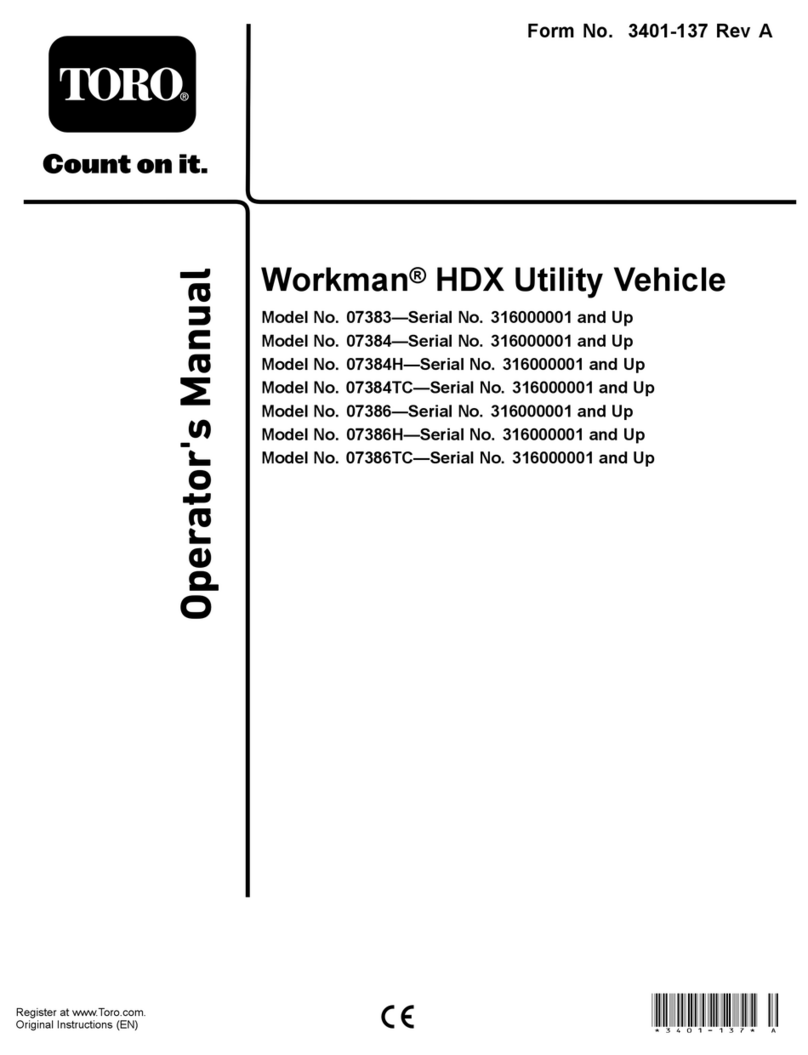
Toro
Toro 7383 Operator's manual
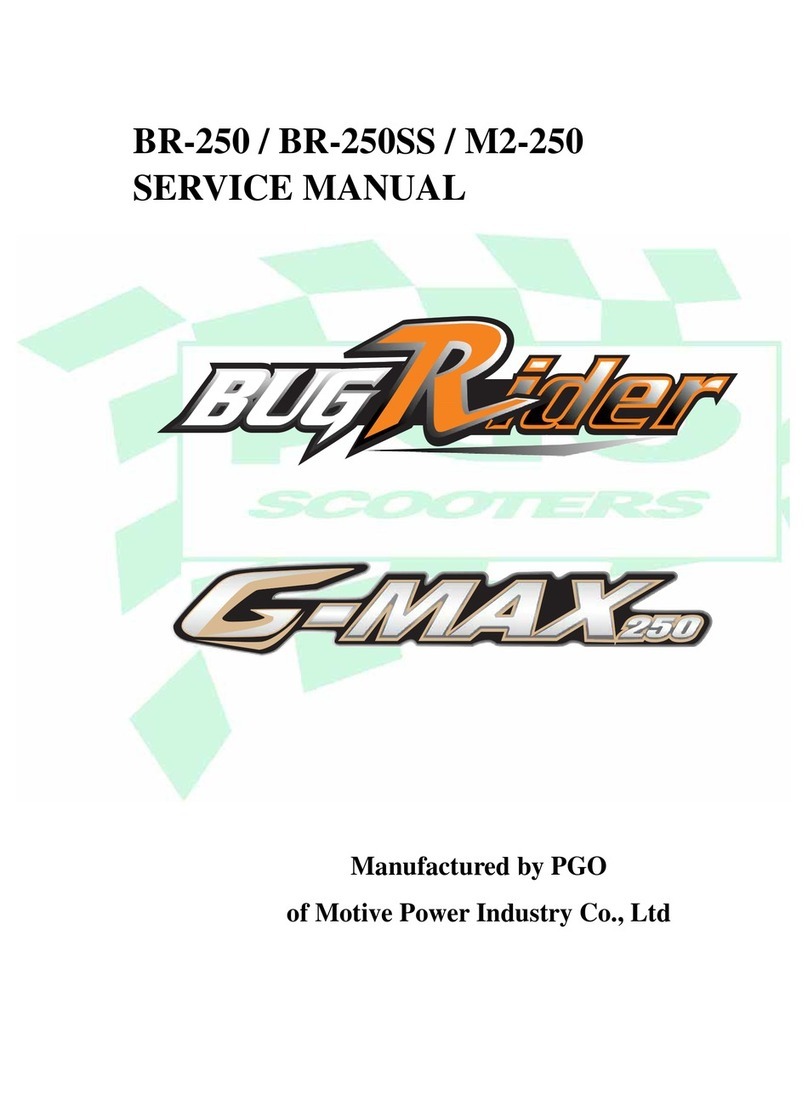
PGO
PGO Bug Rider BR-250 Service manual

Ifor Williams Trailers
Ifor Williams Trailers Transporta CCT 5221 User handbook

American Sportworks
American Sportworks 200 SERIES owner's manual

Primo Water
Primo Water UT5x8-STND Assembly instructions
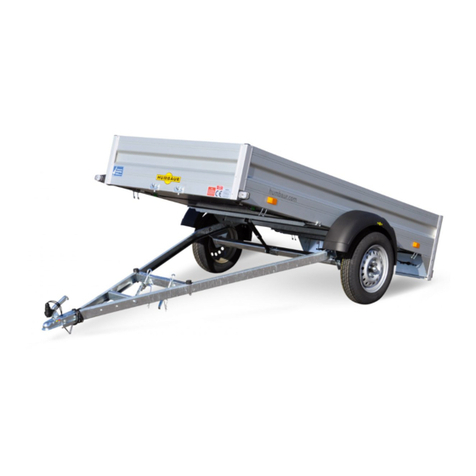
Humbaur
Humbaur 1000 Series operating instructions

